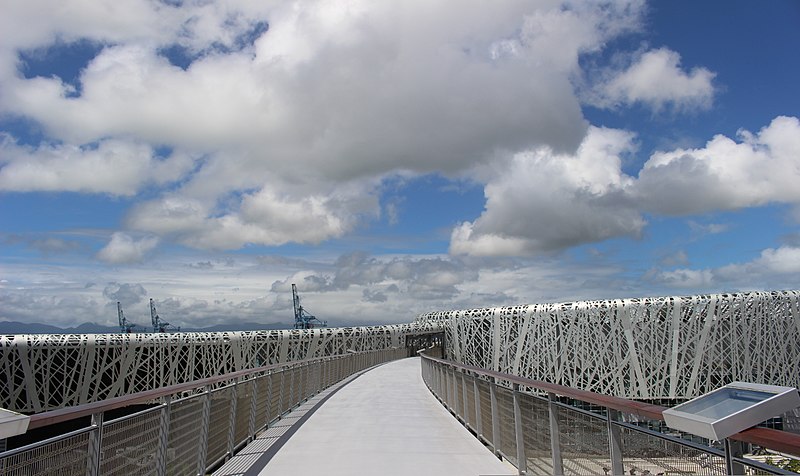The Memorial ACTe/Caribbean Center of Expressions and Memory of the Slave Trade and Slavery is located in Pointe-à-Pitre, Guadeloupe. The Center is part of the Slave Route Project of the United Nations Education, Scientific and Cultural Organization (UNESCO). This project, according to the UNESCO website, was undertaken to remove the “ … ignorance or concealment of major historical events (that) constitute an obstacle to mutual understanding, reconciliation and cooperation among peoples … to break the silence surrounding the slave trade and slavery that have concerned all continents and caused the great upheavals that have shaped our modern societies.”
Initially proposed by Haiti, this UNESCO project was launched in Ouidah, Benin, in 1994, and is centered upon resistance, liberty and heritage. The inclusion of Guadeloupe in this global project was essential, as the island country is integral, regarding construction and greater development of cooperation and harmony, to this international initiative.

The Memorial ACTe, located on the former site of the Darboussier sugar factory, is considered to be the largest museum dedicated to the memory and legacy of slavery and trafficking. Guadeloupe was colonized by France in 1635 and hundreds of thousands of Africans were enslaved and brought to the island, forced to labor on the coffee and sugarcane plantations. There, the brutal and oppressive system of slavery lasted 213 years. When slavery was abolished on April 27, 1848, more than 300,000 Africans had been forced to Guadeloupe to build what would be one of France’s most economically-successful colonies. The descendants of many of those Africans still, in 2019, reside in this island country and they comprise the majority of the population. Their presence perhaps best explains why, of approximately 395,000, inhabitants present in Guadeloupe, approximately 90% identified as “Black” or “Mulatto”.
While the museum has a specific focus on those citizens of Guadeloupe and residents of other countries in the Caribbean directly impacted by human bondage and trafficking, its universal themes are slavery and the reclamation of humanity for all. According to the Guadeloupe Islands Tourist Board, the Memorial ACTe “seeks to preserve the memory of those that suffered during slavery, as well as to foster dialogue about the repercussions and begin to construct a historical conservation of the epoch.”
In shattering the silence surrounding slavery and trafficking, especially in the era of demands for reparations by organizations such as Descendants of Slaves (DOS) and American Descendant of Slaves (ADOS), this cultural site seeks to be a space of both protection and illumination. It seeks to highlight, via anthropology, art, ethnology, genetics, history, research and scholarship, resilience, atonement and reconciliation to transcend tragedies in order to be and live greater in the 21st century. This emphasis is made possible through archival materials; artefacts; audio testimonials in 6 languages, including Creole; documents; images; objects; statues and visual testimonies. The museum is not, according to President of the Regional Council, Victorin Lurel, “… of fine arts or society but is a project of space with multiple activities, multiple approaches, multiple ambitions, whose primary vocation is to ‘live better together.’”
At 77,000 square feet, the Memorial ACTe is an architectural masterpiece! It was designed by Guadeloupe architects Jean-Michel-Célestine, Pascal Berthelot, Mikael Marton and Fabien Dore (Atelier Dore/Marton. More than 300 Guadeloupe workers participated in its construction. The first brick was laid on May 27, 2008 in honor of the abolition of slavery in Guadeloupe.

In an interview, Jacques Martiel, Chairman of the ACTe, stated that the museum was a lighthouse of culture and designed to resemble such a structure. The Memorial ACTe is “… the first thing you see when you arrive in Pointe-à-Pitre Bay from the sea. Symbolically, it was built on the site of the largest sugar factory in the Lesser Antilles, where forced labour was still being used in the 19th century. The building is 240m long, and covered in a silvery mesh. It evokes the overground roots of damned fig trees taking over ruined walls, insinuating themselves between the cracks but also helping them to stay standing. The mesh contains a black box, representing the black peoples. The shards of quartz within represent the souls of victims of slavery and the slave trade. A walkway joins the second floor to the Morne Mémoire on the neighbouring hill, a contemplative garden with superb views of the bay.”
Inside, visitors can experience the permanent exhibition, which contains 6 historic periods that the Memorial ACTe identifies as “archipelagos”: The Americas; Towards Slavery and the Trans-Atlantic Slave Trade; The Slavery Period; Abolition; Post-Abolition and Segregation; and Today. There is also a temporary exhibition room; the media library and research library. There is even a genealogical research area where visitors, having access to more than 6, 000 family trees, may trace their families’ surnames in connections with Guadeloupe. Onsite, you can participate in educational workshops; view screenings as well as live shows in the conference and visual arts hall; take in a meal at one of the dining areas, including the panoramic restaurant; or view the landscape, mountains and sea of Morne Mémoire (Memory Hill Park).
Created from a mission to inform and empower in such monumentally creative and innovative ways, it is no wonder that the Memorial ACTe has been the recipient of critical, international acclaim. The museum won the “Worldwide Category – Highly Commended” Special Award of British Guild of Travel Writers’ in 2015; the “Outstanding Heritage Site” category of African Diaspora World Tourism in 2016; and the Council of Europe Museum Prize in 2017!
